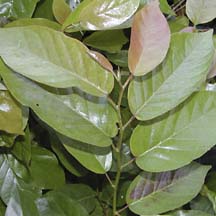
In the Garden![]()
Rick Barboza
HUI KU MAOLI OLA
Hame
LATIN NAME
Antidesma pulvinatum
Description: These are small trees up that can reach heights of 6 to 25 feet.
They have beautiful foliage in terms of their color, which is a glossy maroon when young and a glossy dark green when older; their shape, elliptical with clean margins and a sharp apex; and their arrangement, which alternates tightly along each branch. Flowers develop on panicles which turn into small reddish-purple grapelike fruit. The contrast between the young leaves, mature leaves and fruit make this plant very attractive.
Distribution: This species of Antidesma is not too common, but can occasionally be seen in the dry to mesic forests of Oahu, Molokai, Maui and the Big Island. The one pictured here is from Oahu's Waianae Mountains.
Cultural use: Hame's hardwood is used to make anvils for beating kapa or, more commonly, for preparing olona (Touchardia lattifolia) to make cordage. The dark reddish-purple berries are also used to make a dye for kapa.
Landscape use and care: This tree would make an excellent addition to any garden. Its attractiveness extends well beyond the native plant enthusiast's eyes, and the plant is fairly easy to take care of. Daily watering is fine in well-drained soil, but reduce to watering only when needed once the plant is established.
This plant also thrives in full sun to somewhat filtered sunlight. Young trees are more susceptible to damage from mealy bugs or aphids, but this can be easily remedied by pruning off affected leaves.
More details: This is one of two species of Antidesma native to Hawaii. Both are called hame, but other names for the two include ha'a, ha'amaile, hamehame, mehame and mehamehame (not to be confused with another plant called mehamehame, Fluggea neowawraea, which is an endangered species in the same family, Euphorbiacea).
Gardening Calendar


